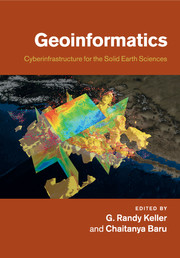Book contents
- Frontmatter
- Contents
- List of contributors
- Preface
- Introduction
- Part I Case studies from other disciplines
- Part II Modeling software and community codes
- Part III Visualization and data representation
- Part IV Knowledge management and data integration
- Part V Web services and scientific workflows
- Part VI Emerging international and other efforts
- 18 It's not your data, it's everyone's: The benefits of a corporate approach to scientific information
- 19 TOPO-EUROPE and cyberinfrastructure: Quantifying coupled deep earth – surface processes in 4-D
- 20 OneGeology – from concept to global project
- 21 Geoinformatics developments in Germany
- 22 iGEON: Networking the Indian geosciences community through GEON
- 23 Geoinformatics in the public service: Building a cyberinfrastructure across the geological surveys
- 24 Application of the US Geoscience Information Network to deploying a national geothermal data system
- Index
- Plate section
- References
19 - TOPO-EUROPE and cyberinfrastructure: Quantifying coupled deep earth – surface processes in 4-D
from Part VI - Emerging international and other efforts
Published online by Cambridge University Press: 25 October 2011
- Frontmatter
- Contents
- List of contributors
- Preface
- Introduction
- Part I Case studies from other disciplines
- Part II Modeling software and community codes
- Part III Visualization and data representation
- Part IV Knowledge management and data integration
- Part V Web services and scientific workflows
- Part VI Emerging international and other efforts
- 18 It's not your data, it's everyone's: The benefits of a corporate approach to scientific information
- 19 TOPO-EUROPE and cyberinfrastructure: Quantifying coupled deep earth – surface processes in 4-D
- 20 OneGeology – from concept to global project
- 21 Geoinformatics developments in Germany
- 22 iGEON: Networking the Indian geosciences community through GEON
- 23 Geoinformatics in the public service: Building a cyberinfrastructure across the geological surveys
- 24 Application of the US Geoscience Information Network to deploying a national geothermal data system
- Index
- Plate section
- References
Summary
Introduction
The earth sciences differ from other scientific disciplines in their focus on processes one cannot easily repeat or control. Examples are the nucleation of earthquakes as brittle failure along faults, or the creeping flow processes in the Earth's interior driving plate tectonics and the geologic activity of our planet. The inherent experimental limitations and the indirect nature of our observations explain the need for sophisticated modeling approaches. And with continued growth of computer hardware performance, the crossing of some long-standing thresholds in capacity and capability computing is finally underway. For instance, it is now feasible to implement earth models having in excess of 1–10 billion grid points, a number that matters because it allows us to overcome in three-dimensional (3-D) models the disparate length scales characteristic of key geologic phenomena: an earthquake rupturing a fault segment over a distance of some 100 km while emanating seismic energy throughout the planet (10 000 km), or the peculiar nature of plate tectonics with deformation concentrated along narrow plate boundaries of 10–100 km width separated by plates of dimension 1 000–10 000 km. But capable hardware and raw compute power are not sufficient by themselves to advance demanding earth system simulations. Equally critical are sophisticated software, visualization tools, data portals, and shared middleware and software libraries, collectively known as cyberinfrastructure.
Cyberinfrastructure forms a comprehensive modeling environment to integrate computing hardware, data, networks, digitally enabled sensors, observatories, and experimental facilities.
- Type
- Chapter
- Information
- GeoinformaticsCyberinfrastructure for the Solid Earth Sciences, pp. 292 - 316Publisher: Cambridge University PressPrint publication year: 2011

